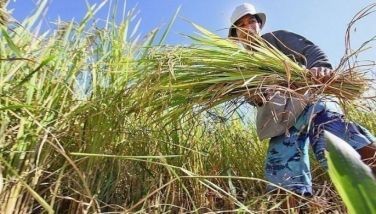New forestry study offers region cold comfort
July 13, 2001 | 12:00am
BANGKOK – Despite excessive drain on timber resources, wood supplies over the next 10 years will keep abreast of the surge in consumption in Asia and the Pacific.
But that’s cold comfort, says a regional forestry sector study towards the year 2010, completed by the Food and Agriculture Organization here.
Deforestation and failure to establish alternate plantations have seen once timber-rich exporting countries like the Philippines skid into importing status, FAO regional forester Patrick Durst adds.
There are already local shortages of specific wood products like large diameter logs, the United Nations agency notes. Demand shows little sign of ebbing, as in China or Thailand.
Forestry in Malaysia and Indonesia account for 10 percent of rich reserves that both are slicing into – with few substitute plantations in the offing.
"(Asia and the Pacific) is already the world’s largest net importing region," the FAO report cautions. "By 2010, (it) will be a net importer of all forest products."
By then, wood demand would come from a population of 3.8 billion, most of them young.
UN Fund for Population tables show that half of the populations in Indonesia, India, Malaysia, the Philippines and Vietnam are below 25 years of age. The proportion is even higher in Bangladesh and Pakistan: 60 percent.
"During the next 15 years, these young people will emerge as increasingly heavy consumers for forest products and services," FAO’s Durst adds. "The future of forestry here is being shaped by their choices today."
FAO foresees that the 2010 forest economy in this region, as largely shaped by these young consumers, will probably contain the following features:
• Sawn wood consumption in Asia and the Pacific will be second in the world – just behind North America.
• The region will grudgingly yield its present lucrative position of net exporter of wood-based panels. Overall, it will start shopping abroad for plywood and other panels.
• The shopping list abroad in 2010 is no longer that of a once lushly-forested region. Asia and the Pacific will import: 16 percent of its industrial roundwood; 18 percent of sawnwood; 28 percent of woodbased panels; nine percent of paper and paperboard; and 11 percent of fiber finish.
• New schools, newspapers and industrial uses will shove regional production of paper and paperboard from the current 75 million metric tons to 130 million MT.
• Use of wastepaper will dramatically expand due to shrinking forests. Imports, "however, will continue to be significant."
• Absolute volume of fuelwood burnt, mostly in households, will continue to rise – although its share in total energy use is declining.
"In the Philippines, fuelwood activities provide the main source of income for 10 percent of rural households," the report adds. "The challenges is to bring wood energy use into the mainstream, including policy agendas.
• The role and value of "non-wood forest products" – from medicinal plants of Mongolia and Nepal to butterfly farms of Papua New Guinea – will command greater attention.
"The perspectives of people living in Asia and the Pacific towards forests are evolving," FAO notes. "The shifts encourage in tandem with "socio-economic changes, emerging perceptions and institutional attitudes." – DEPTHnews
But that’s cold comfort, says a regional forestry sector study towards the year 2010, completed by the Food and Agriculture Organization here.
Deforestation and failure to establish alternate plantations have seen once timber-rich exporting countries like the Philippines skid into importing status, FAO regional forester Patrick Durst adds.
There are already local shortages of specific wood products like large diameter logs, the United Nations agency notes. Demand shows little sign of ebbing, as in China or Thailand.
Forestry in Malaysia and Indonesia account for 10 percent of rich reserves that both are slicing into – with few substitute plantations in the offing.
"(Asia and the Pacific) is already the world’s largest net importing region," the FAO report cautions. "By 2010, (it) will be a net importer of all forest products."
By then, wood demand would come from a population of 3.8 billion, most of them young.
UN Fund for Population tables show that half of the populations in Indonesia, India, Malaysia, the Philippines and Vietnam are below 25 years of age. The proportion is even higher in Bangladesh and Pakistan: 60 percent.
"During the next 15 years, these young people will emerge as increasingly heavy consumers for forest products and services," FAO’s Durst adds. "The future of forestry here is being shaped by their choices today."
FAO foresees that the 2010 forest economy in this region, as largely shaped by these young consumers, will probably contain the following features:
• Sawn wood consumption in Asia and the Pacific will be second in the world – just behind North America.
• The region will grudgingly yield its present lucrative position of net exporter of wood-based panels. Overall, it will start shopping abroad for plywood and other panels.
• The shopping list abroad in 2010 is no longer that of a once lushly-forested region. Asia and the Pacific will import: 16 percent of its industrial roundwood; 18 percent of sawnwood; 28 percent of woodbased panels; nine percent of paper and paperboard; and 11 percent of fiber finish.
• New schools, newspapers and industrial uses will shove regional production of paper and paperboard from the current 75 million metric tons to 130 million MT.
• Use of wastepaper will dramatically expand due to shrinking forests. Imports, "however, will continue to be significant."
• Absolute volume of fuelwood burnt, mostly in households, will continue to rise – although its share in total energy use is declining.
"In the Philippines, fuelwood activities provide the main source of income for 10 percent of rural households," the report adds. "The challenges is to bring wood energy use into the mainstream, including policy agendas.
• The role and value of "non-wood forest products" – from medicinal plants of Mongolia and Nepal to butterfly farms of Papua New Guinea – will command greater attention.
"The perspectives of people living in Asia and the Pacific towards forests are evolving," FAO notes. "The shifts encourage in tandem with "socio-economic changes, emerging perceptions and institutional attitudes." – DEPTHnews
BrandSpace Articles
<
>
- Latest
Latest
Latest
November 9, 2024 - 3:43pm
By E.H. Edejer | November 9, 2024 - 3:43pm
June 9, 2024 - 5:55pm
By Alberto Peña | June 9, 2024 - 5:55pm
May 24, 2024 - 10:00am
May 24, 2024 - 10:00am
May 14, 2024 - 3:43pm
By Ian Laqui | May 14, 2024 - 3:43pm
April 10, 2024 - 5:12pm
By Ian Laqui | April 10, 2024 - 5:12pm
Recommended






























